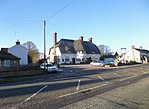All Saints Church, Scholar Green
19th-century Church of England church buildingsChurch of England church buildings in CheshireChurches completed in 1864Diocese of ChesterGeorge Gilbert Scott buildings ... and 3 more
Gothic Revival architecture in CheshireGothic Revival church buildings in EnglandGrade II* listed churches in Cheshire

All Saints Church is in the village of Scholar Green in the parish of Odd Rode, Cheshire, England. It is an Anglican parish church in the deanery of Congleton, the archdeaconry of Macclesfield, and the diocese of Chester. The church is recorded in the National Heritage List for England as a designated Grade II* listed building.The church continues to be active, and works in association with the other churches in the parish, the Church of the Good Shepherd, Rode Heath, and St Luke's Mission Church, Mow Cop.
Excerpt from the Wikipedia article All Saints Church, Scholar Green (License: CC BY-SA 3.0, Authors, Images).All Saints Church, Scholar Green
Church Lane,
Geographical coordinates (GPS) Address Nearby Places Show on map
Geographical coordinates (GPS)
| Latitude | Longitude |
|---|---|
| N 53.1142 ° | E -2.2645 ° |
Address
Church Lane
ST7 3QN , Odd Rode
England, United Kingdom
Open on Google Maps








